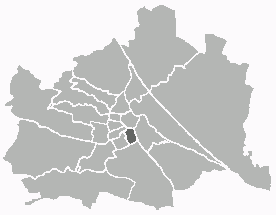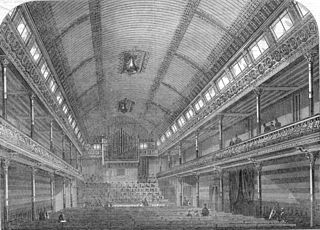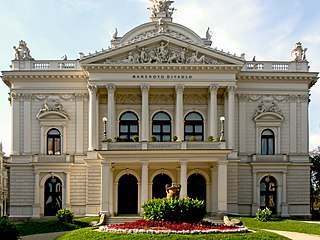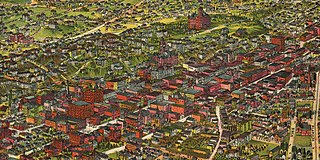
The Ringtheater was a popular theater in Vienna, Austria. In 1881, it was destroyed in the Ringtheater fire that killed 384 people. The site now houses the federal headquarters of police for Vienna.

The Ringtheater was a popular theater in Vienna, Austria. In 1881, it was destroyed in the Ringtheater fire that killed 384 people. The site now houses the federal headquarters of police for Vienna.

The Ringtheater was built between 1872 and 1874 by Heinrich von Förster, following plans by Emil Ritter. It opened on January 17, 1874, under the direction of Albin Swoboda, Sr. as an 'Opéra Comique', antithetical to the "seriousness" of the Vienna State Opera, then called the Court Opera ('Hofoper'). However, in September 1878, the focus was shifted to spoken plays, German and Italian opera and variety, and the name was changed to the "Ringtheater".

Given that the footprint of the theatre was small—and the theatre was intended to hold an audience of 1700—the architect was forced to build high, but with disastrous consequences. On December 8, 1881, a fire broke out shortly before a performance of Les contes d'Hoffmann , [1] and 384 people were killed. [2] The following year, a new law was passed, regarding the outfitting and safety provisions, including safety curtains, outwards-opening doors and fireproofing of the set.
An apartment building called the Sühnhaus was built on the site of the Ringtheater out of Emperor Franz Joseph's private funds; it was a private residence, which supported worthy causes. This was badly damaged by fire in 1945 and eventually collapsed in 1951. Between 1969 and 1974, an office block was erected on the site, in which the federal headquarters for police in Vienna and the general inspectorate of the federal security guards, and police commandos are housed. The fire is commemorated on a plaque on the police building. The Attic style statues, which had stood on the pilasters, are now in the Pötzleinsdorfer Schlosspark.

The Savoy Theatre is a West End theatre in the Strand in the City of Westminster, London, England. The theatre was designed by C. J. Phipps for Richard D'Oyly Carte and opened on 10 October 1881 on a site previously occupied by the Savoy Palace. Its intended purpose was to showcase the popular series of comic operas of Gilbert and Sullivan, which became known as the Savoy operas.

The Vienna State Opera is an opera house and opera company based in Vienna, Austria. The 1,709-seat Renaissance Revival venue was the first major building on the Vienna Ring Road. It was built from 1861 to 1869 following plans by August Sicard von Sicardsburg and Eduard van der Nüll, and designs by Josef Hlávka. The opera house was inaugurated as the "Vienna Court Opera" in the presence of Emperor Franz Joseph I and Empress Elisabeth of Austria. It became known by its current name after the establishment of the First Austrian Republic in 1921. The Vienna State Opera is the successor of the old Vienna Court Opera. The new site was chosen and the construction paid by Emperor Franz Joseph in 1861.

The Opera Comique was a 19th-century theatre constructed in Westminster, London, between Wych Street, Holywell Street and the Strand. It opened in 1870 and was demolished in 1902, to make way for the construction of the Aldwych and Kingsway.

Meiningen is a town in the southern part of the state of Thuringia, Germany. It is located in the region of Franconia and has a population of around 25,000 (2021). Meiningen is the capital and the largest town of the Schmalkalden-Meiningen district. From 1680 to 1920, Meiningen was the capital of the Duchy of Saxe-Meiningen.

The Vienna Ring Road is a 5.3 km circular grand boulevard that serves as a ring road around the historic Innere Stadt district of Vienna, Austria. The road is located on sites where medieval city fortifications once stood, including high walls and the broad open field ramparts (glacis), criss-crossed by paths that lay before them.

Wieden is the 4th municipal district of Vienna, Austria. It is near the centre of Vienna and was established as a district in 1850, but its borders were changed later. Wieden is a small region near the city centre. After World War II, Wieden was part of the Soviet sector of Vienna for 10 years.

The Vienna Volksoper is an opera house in Vienna, Austria. It produces three hundred performances of twenty-five German language productions of opera, operetta, musicals, and ballet, during an annual season which runs from September through June.

The history of Regina, Saskatchewan, the capital of the Canadian province of Saskatchewan. Prior to the province's establishment, Regina served as the territorial headquarters of the then-North-West Territories and district headquarters of the territorial district of Assiniboia.

Fellner & Helmer was an architecture studio founded in 1873 by Austrian architects Ferdinand Fellner and Hermann Helmer.

Wien Südbahnhof was Vienna's largest railway terminus. It closed in December 2009 and was demolished in 2010 to be replaced with a new station, Wien Hauptbahnhof. It was located in Favoriten, in the south-east of the city. The East-bound rail services of Südbahnhof remained in operation until 2012 at a temporary train station "Südbahnhof (Ostbahn)".

The Royal Opera House, also known as the Royal Theatre, was an opera house and performing arts venue in Valletta, Malta. It was designed by the English architect Edward Middleton Barry and was erected in 1866. In 1873 its interior was extensively damaged by fire but was eventually restored by 1877. The theatre received a direct hit from aerial bombing in 1942 during World War II. Prior to its destruction, it was one of the most beautiful and iconic buildings in Valletta. After several abandoned plans to rebuild the theatre, the ruins were redesigned by the Italian architect Renzo Piano and in 2013 it once again started functioning as a performance venue, called Pjazza Teatru Rjal.

St. George's Hall was a theatre located in Langham Place, off Regent Street in the West End of London. It was built in 1867 and closed in 1966. The hall could accommodate between 800 and 900 persons, or up to 1,500 persons including the galleries. The architect was John Taylor of Whitehall.

Theater am Kärntnertor or Kärntnertortheater was a prestigious theatre in Vienna during the eighteenth and nineteenth centuries. Its official title was Kaiserliches und Königliches Hoftheater zu Wien.

The Carltheater was a theatre in Vienna. It was in the suburbs in Leopoldstadt at Praterstraße 31.
Main Street is a major north–south thoroughfare in Los Angeles, California. It serves as the east–west postal divider for the city and the county as well.

Mahen Theatre is a Czech theatre situated in the city of Brno. Mahen Theatre, built as German Deutsches Stadttheater in 1882, was one of the first public buildings in the world lit entirely by electric light. It was built in a combination of Neo-renaissance, Neo-baroque and Neoclassical architectural styles.

The Ringtheater fire occurred on 8 December 1881, in the popular Viennese Ringtheater, named after the road it was located at, the Schottenring. Before the fire, the privately run theater, with a capacity of about 1700 visitors, suffered from financial problems. Officially, 384 people perished in the fire, though there are higher estimates. For example, the Prussian-born author and encyclopedian Ludwig Julius Eisenberg (1858–1910) claims that up to one thousand could have been killed.
In New York City during the early 20th Century, regulations were enacted which required uniformed fire department officers to be permanent attendees of every theatrical production. These Theatre Detail Officers were required to be in the theatre a half-hour before the performance, test the fire alarms, inspect fire wall doors and the fire curtain, and, during performances, ensure that aisles, passageways and fire exits remain clear and accessible.

The late-Victorian-era Downtown of Los Angeles grew year by year, around 1880 centered at the southern end of the Los Angeles Plaza area, and over the next two decades, extending south and west along Main Street, Spring Street, and Broadway towards Third Street. Most of the 19th-century buildings no longer exist, surviving only in the Plaza area or south of Second Street. The rest were demolished to make way for the Civic Center district with City Hall, numerous courthouses, and other municipal, county, state and federal buildings, and Times Mirror Square. This article covers that area, between the Plaza, 3rd St., Los Angeles St., and Broadway, during the period 1880 through the period of demolition (1920s–1950s).

The Landestheater Niederösterreich is a Schauspielhaus in the Lower Austrian provincial capital St. Pölten.
Most of the information in this article is taken from the German Wikipedia article.